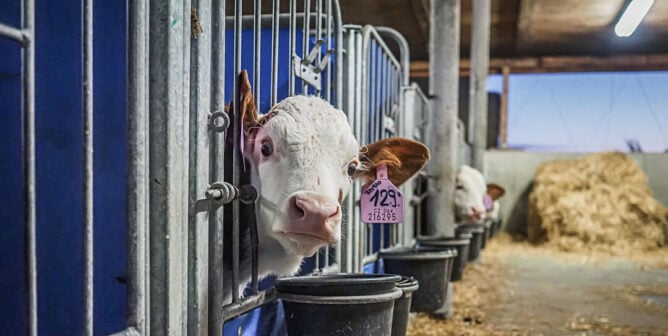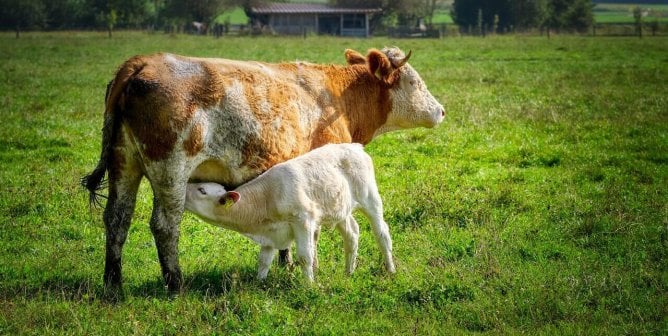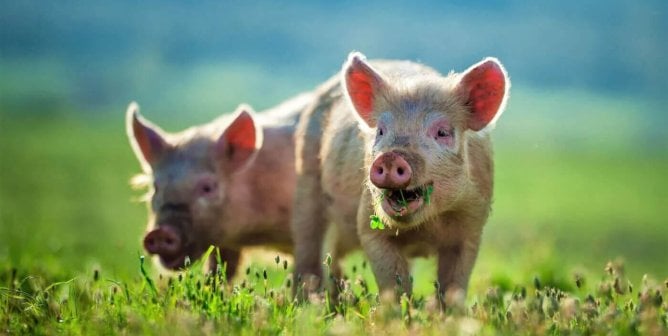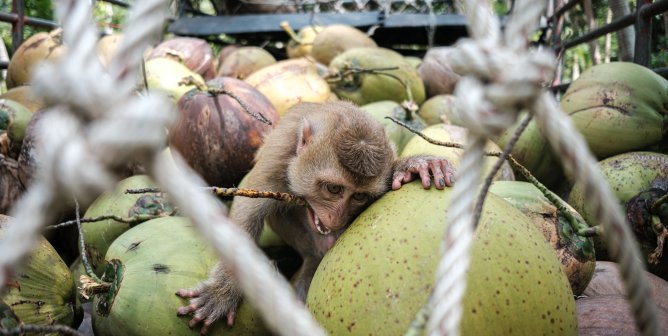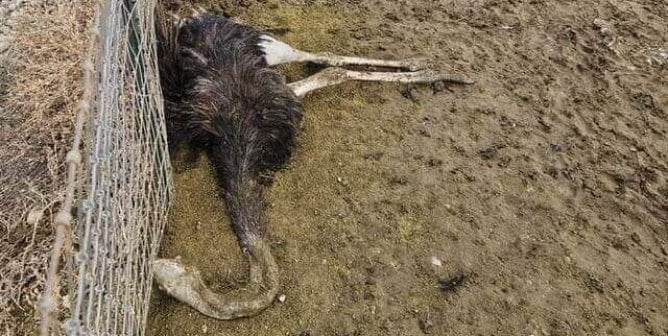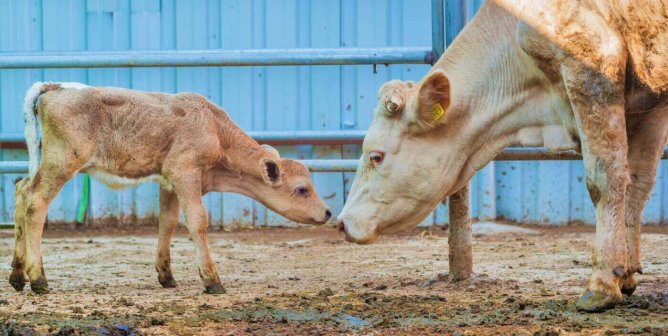Animal Agriculture Increases the Risk of Pandemics
Three out of every four emerging infectious diseases in humans originate in animals and are in part caused by our reliance on animal agriculture—the farming of animals for food, clothing, and other purposes.1 These types of pathogens are zoonotic, meaning that they form in animals and can be transmitted to humans. The majority of diseases that have caused epidemics or pandemics in recent years are zoonotic, including AIDS, avian flu, swine flu, SARS, MERS, Ebola, Zika, and COVID-19.2 In light of this, expert bodies like the World Health Organization (WHO), the Food and Agriculture Organization (FAO) of the United Nations, and the World Organisation for Animal Health (OIE) have long predicted that as long as humans continue to rely on animals for food and profit, pandemics are inevitable.3
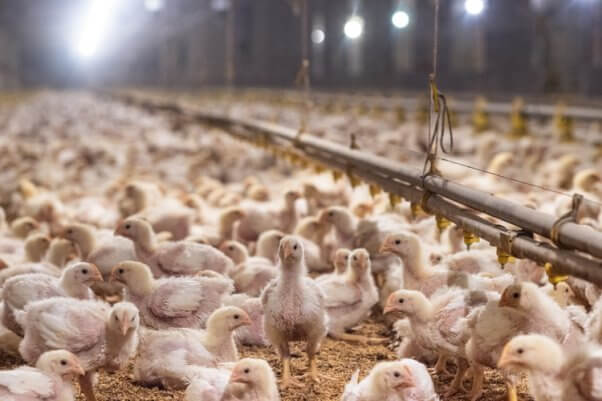
How Are Zoonotic Diseases Spread to Humans?
Zoonotic diseases can be spread to humans who have direct or indirect contact with animals or animal “products.” Direct contact can occur when someone touches or is bitten or scratched by an animal. Indirect contact can occur when someone comes into contact with an area where animals live, including their enclosure or feeding area. Zoonotic diseases can also be vector-borne, waterborne, and foodborne. Vector-borne zoonotic diseases may be contracted by humans who are bitten by a tick or an insect who has recently fed on a contaminated animal. Waterborne zoonotic diseases spread to humans who come into contact with or drink water that has been contaminated with feces from an infected animal. Foodborne zoonotic diseases spread to humans who touch or consume foods derived from a contaminated animal, such as meat, eggs, or dairy.
Using Animals for Profit Creates Hotspots for Zoonotic Diseases
By breeding and raising animals, we are creating hotspots for zoonotic diseases. Ninety percent of the world’s meat supply4 comes from factory farms, and that figure is 99% in the U.S.5 On these farms, cows, pigs, chickens, and other animals are bred and raised by the thousands in cramped and unsanitary conditions, often surrounded by their own waste and deprived of fresh air and sunlight. These conditions cause animals extreme stress and anxiety and create the perfect breeding ground for pathogens.
Selective breeding and the common use of antibiotics also contribute to the disease risk. On today’s large-scale farms, animals are selectively bred for profitable traits (think larger breasts, faster egg production, etc.). This results in a loss of genetic diversity among a population of animals. For viruses and bacteria, this is an ideal situation, as pathogens can quickly jump from individual to individual without meeting genetic variants that might slow them down.6 Within a matter of days, an entire population could be infected. To make matters worse, because farmers frequently administer antibiotics to the animals in order to promote quick growth, many of them develop antibiotic resistance, making it even more difficult to treat or prevent the spread of infection.7 Furthermore, consuming foods derived from antibiotic-resistant animals can have a devastating impact on human health. This lethal mix of zoonotic disease and antibiotic resistance has prompted expert groups to recognize animal health as “the weakest link in our global health chain”—because once animals get sick, humans are usually quick to follow.8
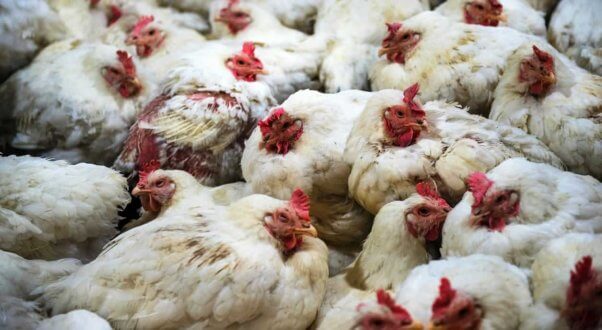
Health Impacts on Farm and Slaughterhouse Workers
Farm and slaughterhouse workers are among the most at-risk groups for contracting zoonotic diseases. They routinely come into contact with animal feces, urine, and blood, making animal-to-human disease transmission highly likely. The H1N1 swine flu strain that infected millions of people and killed over 18,000 in the 2009 pandemic is thought to have first infected pigs on factory farms, where it was transmitted to farmworkers who eventually spread it to members of the public.9
Farm and slaughterhouse employees are also at high risk of human-to-human disease transmission owing to the unhygienic and cramped conditions in which they work. Slaughterhouse workers typically stand shoulder to shoulder at assembly lines, making it impossible to maintain social distancing during the COVID-19 pandemic. As a result, by the end of June 2020 over 27,000 slaughterhouse workers across the U.S. had contracted the disease and several had died.10 Nearly all the U.S. meat industry giants, including Tyson, Smithfield Foods, and JBS USA, reported outbreaks at their facilities.11 Many of these workers are not paid a living wage, and some are undocumented immigrants with limited employment opportunities.12 Not only do meat companies fail to provide their workers with a safe and sanitary working environment, many also neglect to offer fully paid sick leave, leaving already vulnerable workers further marginalized.
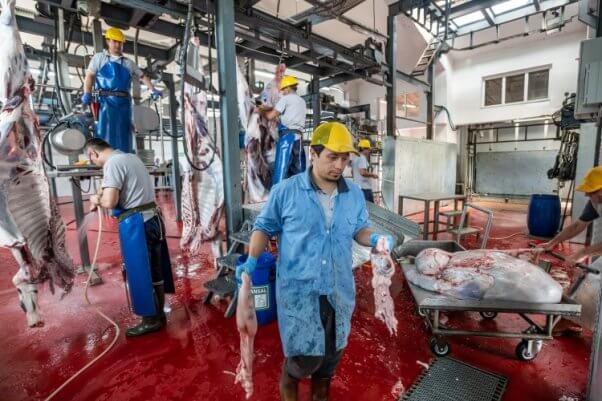
Health Impacts on the Public
The health impacts of animal agriculture extend far beyond its workers. Outbreaks that originate in animals used for food can spread to the general public in two ways: consumption of an infected animal and contact with infected farmworkers.
The Centers for Disease Control and Prevention (CDC) estimates that one in six Americans gets sick each year from eating contaminated food, including meat, eggs, and dairy from sick animals and fruits and vegetables that have been contaminated with feces from infected animals.13 Common foodborne pathogens include salmonella, campylobacter, yersinia, E. coli, and listeria.14
Zoonotic diseases can also spread from farms to the public through human-to-human transmission via an infected farmworker. Communities that have a large population working in animal agriculture are therefore more at risk of experiencing an outbreak. One study found that when factory-farm workers or others working with animals comprised between 15% and 45% of a community, human influenza cases increased by a whopping 42% to 86%.15
Once one community is infected, if the virus is contagious enough, the outbreak can keep expanding, eventually causing a full-blown pandemic. The highly pathogenic avian influenza strain H5N1, for example, is thought to have originated at poultry farms in Hong Kong in 1997.16 Despite various efforts to contain the outbreak, the disease quickly spread throughout domesticated poultry in most of Southeast and East Asia, resulting in hundreds of confirmed human cases and deaths. Various different strains of avian flu have emerged and reemerged since then, and scientists have found that almost all of them originated in commercial poultry production systems.17 As previously mentioned, all strains of swine flu have originated in animal agriculture. In fact, every influenza strain in history has originated in animals, including the H1N1 virus that caused the 1918 pandemic that killed over 50 million people worldwide.18
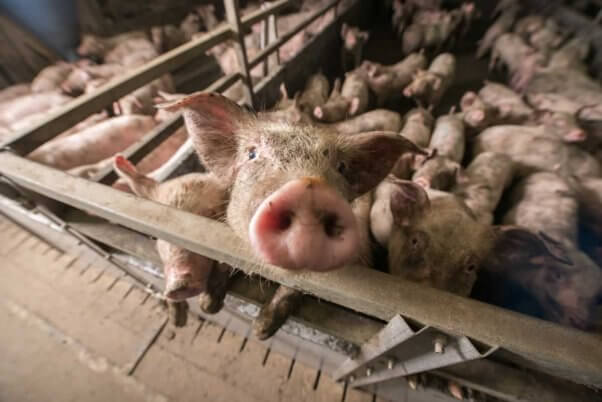
This Is a Global Issue
Outbreaks of zoonotic diseases can occur anywhere. A study found that the majority of avian flu outbreaks in recent years have occurred in high-income countries.19 Notably, it concluded that the U.S., Europe, and Australia have generated more strains of avian flu than China has. This makes sense, as Western nations rely particularly heavily on factory farming for their meat supply.20 Although the origins of most pandemics are debated, it is widely believed that the 1918 influenza outbreak referred to as “Spanish flu”—the deadliest pandemic in recent history—actually developed not in Spain but on U.S. farms.21
Foodborne illnesses are also prevalent in the U.S. The U.S. Department of Agriculture Food Safety and Inspection Service reports that 15% of raw meat (including chicken, turkey, and ground beef) sold in the country is contaminated with Salmonella enterica or Salmonella typhimurium, potentially deadly bacteria that cause serious gastrointestinal issues. As a result, there are over 1 million salmonella infections, thousands of hospitalizations, and hundreds of deaths in the U.S. every year.21 These examples highlight that neither the quality of a country’s infrastructure nor the stringency of its farm regulations can eliminate the risk of zoonotic diseases. Pathogens will continue to emerge and reemerge where animal agriculture persists, eventually leading to yet another devastating pandemic.
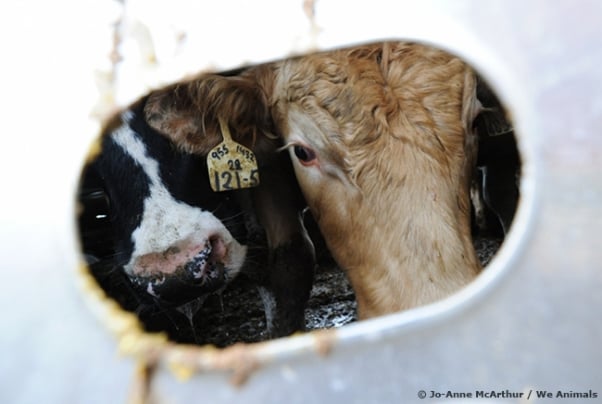
What You Can Do to Prevent Zoonotic Disease Pandemics
One of the most effective ways to decrease the risk of pandemics is to prevent pathogens from emerging in the first place by moving away from animal agriculture. Companies investing in vegan food and cutting ties with animal agriculture would easily spare millions of animal and human lives. Crises like the COVID-19 pandemic show that we have a collective responsibility to mitigate public health risks. Being vegan should therefore be viewed not as a personal choice but as a duty to our global community.
References
1 CDC, “Zoonotic Diseases,” 14 July 2017.
2 Leslie A. Reperant and Albert D.M.E. Osterhaus, “AIDS, Avian Flu, SARS, MERS, Ebola, Zika… What Next?” Vaccine, 35.35 (2017): 4470–4474.
3WHO, FAO, OIE, and the Health Council of the Netherlands, “Report of the WHO/FAO/OIE Joint Consultation on Emerging Zoonotic Diseases,” 3–5 May 2004.
4Kelly Anthis, “Global Farmed & Factory Farmed Animals Estimates,” Sentience Institute, 21 Feb. 2019.
5 Jacy Reese Anthis, “US Factory Farming Estimates,” Sentience Institute, 11 Apr. 2019.
6 Sigal Samuel, “The Meat We Eat Is a Pandemic Risk, Too,” Vox, 10 June 2020.
7 Emanuel Goldman, “Antibiotic Abuse in Animal Agriculture: Exacerbating Drug Resistance in Human Pathogens,” Human and Ecological Risk Assessment, 10.1 (2004): 121–134.
8FAO, “World Livestock 2013: Changing Disease Landscapes,” 2013.
9Charles W. Schmidt, “Swine CAFOs & Novel H1N1 Flu: Separating Facts From Fears,” Environmental Health Perspectives, 117.9 (2009): A394–A401.
10Leah Douglas, “Covid-19 Shows No Sign of Slowing Among Food-System Workers,” Food & Environment Reporting Network, 22 June 2020.
11Kate Taylor, “A Lawsuit Alleges Slaughterhouse Employees Weren’t Given Time to Wash Hands or Wipe Their Noses, as More Than 1,800 Workers at Meat Plants Across America Catch COVID-19,” Business Insider, 24 Apr. 2020.
12William Roberts, “Workers in Iowa Meat Industry Fear Returning to Processing Plants,” Al Jazeera, 8 May 2020.
13CDC, “Zoonotic Diseases.”
14European Food Safety Authority, “Foodborne Zoonotic Diseases,” 4 Feb. 2020.
15Roberto A. Saenz, Herbert W. Hethcote, and Gregory C. Gray. “Confined Animal Feeding Operations as Amplifiers of Influenza,” Vector-Borne & Zoonotic Diseases, 6.4 (2006): 338–346.
16M. Peiris and H.-L. Yen, “Animal and Human Influenzas,” Revue scientifique et technique (International Office of Epizootics), 33.2 (2014): 539–553.
17Madhur S. Dhingra et al. “Geographical and Historical Patterns in the Emergences of Novel Highly Pathogenic Avian Influenza (HPAI) H5 and H7 Viruses in Poultry,” Frontiers in Veterinary Science, 5 (2018): 84.
18CDC. “1918 Pandemic,” 20 Mar. 2019.
19Dhingra et al.
20Reese Anthis.
21John M. Barry, “The Site of Origin of the 1918 Influenza Pandemic and Its Public Health Implications,” Journal of Translational Medicine, 2.1 (2004): 3.
22CDC, “Salmonella,” 25 Mar. 2020.

